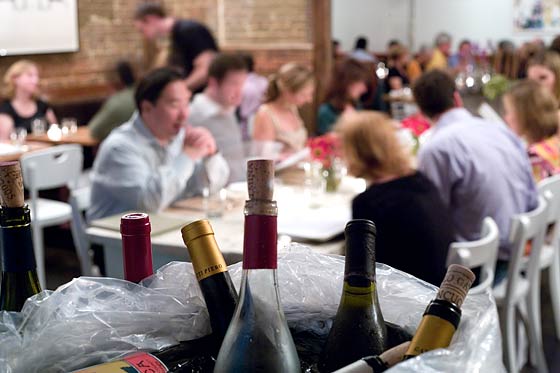
I last visited the original Tasting Room several months ago, in the depths of winter. Even on a dank, cold evening, the tables at the well-known little restaurant, down on 1st Street, on the lower fringe of the East Village, were filled. The prim-looking couples studied their menus with Talmudic intensity, took exacting sips of wine, and rhapsodized, the way food people are prone to do, about the little scraps of scallop on their plates. My own experience wasn’t so rhapsodic, however. The room felt cramped and drafty. Our waitress stood absently by the bar while we waved at her for five minutes, and thereafter conducted herself with an impressive, almost Parisian combination of arrogance and hauteur. The food wasn’t much better. My duck appetizer was tough, the scallop entrée meager, the desserts too insignificant to recall. Along with Prune, down the street, the little establishment, which opened in 1999, was one of the pioneers of the downtown gourmet revolution. But by the time I visited, the revolution had spread far and wide, and the operation felt quaint and slightly dated, as if it were running on fumes.
Perhaps the proprietors, Colin Alevras and his wife, Renée, sensed the same thing. This summer, they closed down the old East Village venue for renovations. Now they’ve opened a larger, more expansive branch in Nolita, among the swank storefront boutiques on Elizabeth Street. This brand-new restaurant (the original space will reopen as a wine bar later this fall) seats 80 people instead of 25. There is a wine-storage space hewn from rough planks of wood in the front of the house, and a bar lined with pickle jars that serves a variety of old-style cocktails mixed, in accordance with current downtown fashion, with artisanal ingredients like housemade bitters and home-brewed ginger ale. The windowless dining space in the back is much bigger than that of the original restaurant, and decorated in a style that might be described as Haute Barnyard, with a long, communal farm table in the middle of the room, dimly lit booths in the back, and artsy depictions of painted sheep, oversize chicken bones, and giant, sculptural tangerine peels scattered over the brick walls.
At the original Tasting Room, Alevras served as the chef and Renée as the hostess, and that’s how the duties are divided here. The menu, printed daily, is still obsessively market-driven (you could describe it as Haute Barnyard, too) and replete with esoteric seasonal ingredients (dandelion greens, emmerite beans, lovage) and the names of many of the farms that grow them. But it’s been blown out to include many new dishes, several of them priced considerably higher than any of the old ones (in fairness, the dishes also tend to be larger). On my first visit, there were ten entrées to choose from, six of which cost over $30, including two scallops for $30 and an admittedly delicious compilation of lobster mushroom and pork cracklings for $32. On the lower end of this spectrum, a bowl of complex, even tasty, pear-and-whey soup (flavored with fennel and served cold) costs $8, and for $12 you can get an appetizer portion of candy-sweet heirloom tomatoes garnished with long, feathery dandelion greens and a scattering of soft, locally produced ricotta cheese.
Once you get over this sticker shock, however, it’s clear that Alevras has been somewhat reinvigorated by his new surroundings. He has a special knack for highlighting unusually earthy ingredients and shuffling them together in a deceptively simple, pleasing style. I’ve been eating around town for several years now, but I’ve never enjoyed silvery fillets of butterfish served cold, in the escabèche style, over a pile of pimiento peppers, pickled onions, and the kind of long, sinuous lunga beans you see ladies carrying around in bundles down in Chinatown, as I did here. Lamb shoulder is served as an appetizer in cool pink slices, with a nutritious Greenmarket weed called lamb’s quarters and a sidecar of sweet green-tomato chutney. And if you’re a connoisseur of orange surf clams, you’ll find them mixed into a cold salad one evening (with potatoes, puntarelle, and a sprinkling of tomato seeds), or floating in a giant clam shell as part of a creamy, garlicky chowder, mingled with bits of braised pork and croutons of crunchy farm bread.
Instead of big-ticket cuts of environmentally questionable beef on the entrées portion of the menu, Alevras indulges in mushrooms (although I have a feeling that beef may appear on the menu when the weather gets colder). Some of these righteous experiments in slow cooking work better than others. One evening, I plunked down $38 for a plate of runty pork-wrapped matsutake mushrooms, which tasted almost as dirty as they looked. A pile of chanterelles with an egg broken into them tasted fine, but $32 seemed like a lot to pay for what is essentially a side dish. If you have that kind of cash, try the roasted porcinis, cut in thick slabs and served, like some Hungry-Man Greenmarket breakfast, with a blood sausage (made from buckwheat) and a fried egg. For a less virtuous but possibly more satisfying dinner, try the pulled-pork shanks (over sweet potatoes) or the braised goat stuffed with ground liver, sage, and pork fat. The best poultry entrée I encountered was the breast of guinea hen (with broccoli rabe and red onions), and the best fish was something called Triple Tail (a.k.a. dusky perch), presented in a creamy succotash of sweet corn and wild tomatoes.
The service can be achingly slow at the new Tasting Room, and in the big new room, the intimacy that comes with dining in a small space is lost. But if you wish to tap into what Greenmarket cooking was like before everyone tried doing it, this isn’t a bad place to be. The desserts tend to be familiar recipes, prepared with all due attention to detail, and a subtle twist. I liked most of them, particularly a deconstructed lemon meringue pie (with a light almond cookie crust), and a smooth rendition of peach cobbler, topped with ice cream flavored with peach leaf. There’s also a rich dark-chocolate torte, served with a crunchy caramel sauce, and cheesecake, made with crème fraîche, muddled with strawberries. For the ultimate in barnyard chic, however, try the brioche bread pudding, garnished with Honey Crisp apples, and splashed, in high country style, with a hint of Calvados.
The Tasting Room
Address: 264 Elizabeth St., nr. Houston St.; 212-358-7831
Hours: Dinner, Tuesday through Thursday, 6 to 10:30 p.m. Friday and Saturday until 11. Sunday until 9 p.m.
Prices: Appetizers, $8 to $22; entrées, $24 to $40.
Ideal Meal: Cold roast lamb shoulder, guinea hen, roasted porcinis, bread pudding.
Note: The menu changes constantly, but the excellent cocktails remain the same. Try the Dark and Stormy, made with home-brewed ginger beer.
Scratchpad: Two of the meals here were two-stars good, one wasn’t good at all. I’m willing to give this seminal foodie couple the benefit of the doubt.
